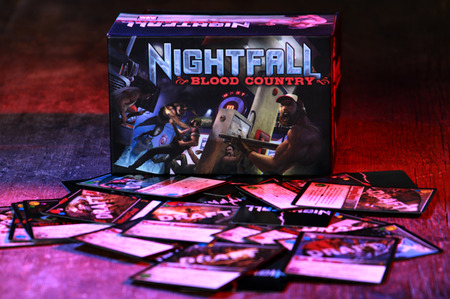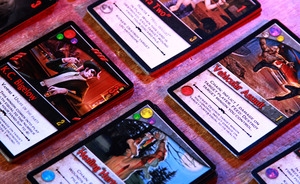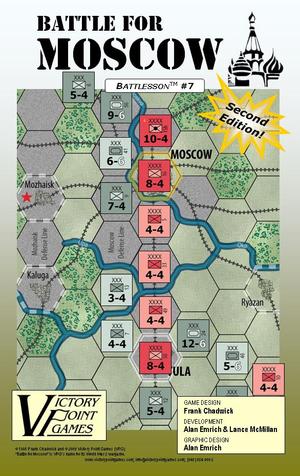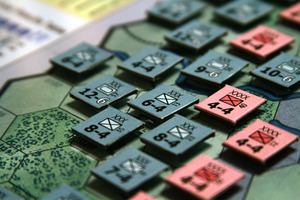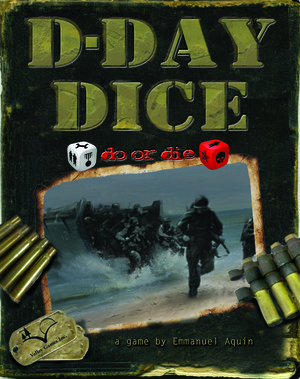
I have been keeping tabs on a few of the new board game projects utilizing Kickstarter as a platform to springboard publication. One such title is D-Day Dice, designed by Emmanuel Aquin, and scheduled for publication by Valley Games. The D-Day Dice Kickstarter hit the ground running with incredible momentum, achieving its target funding within 24 hours - but there are still a lot of great goodies to be unlocked within the next few weeks if the stretch goals are reached.
D-Day Dice is a dice based multi-player co-op WWII themed game focused around the organization of resources at hand to build and direct a unit of Allied forces against a German machine gun nest. In it's simultaneous play model, players must effectively manage the resources that are rolled on the dice, and work together to choose how best to utilize their resources.
Game designer Emmanuel Aquin was kind enough to speak with us a bit about himself, his game, and the design process of D-Day Dice. More information about the game can be found on it's Kickstarter page at: http://www.kickstarter.com/projects/1325766284/d-day-dice-board-game
Nerdbloggers:
Thanks for taking the time out of your busy schedule to talk to us! First of all, can you tell us a little about yourself? You have a very interesting background that may resonate with a good number of our readers.
Emmanuel Aquin:
I'm a little French-Canadian with a very uninteresting background. The only thing of interest is that my father, Hubert Aquin, was a very well-known Quebec novelist and intellectual.
I have been all over the place, so focus may not be my best quality. I started as a novelist (wrote my first published novel when I was 20), then I went on publishing 3 more novels until 1995 (when I was 27). These are all "serious" novels -- in French, no less :-). Then, needing a change of pace, I went on publishing a couple of absurd sci-fi novels, in the vein of Alice in Wonderland and the Hitch-Hiker's 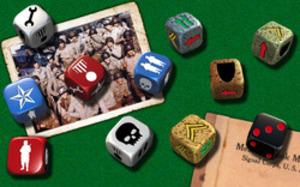 Guide to the Galaxy. I also did some illustrations for school books (I wanted to be a comic-book artist when I was younger).
Guide to the Galaxy. I also did some illustrations for school books (I wanted to be a comic-book artist when I was younger).
Then I was convinced by my then-girlfriend to start my own publishing house. So I became an editor (I was an assistant-editor before), layout artist, graphic designer and illustrator. I also created an erotic collection, in which I published 4 erotic books. These were very tongue-in-cheek (ouch!) and done in the spirit of the Oulipo French movement of the late 50s (like George Perec and Raymond Queneau, for those of you with checklists). It sounds artsy-fartsy, said like that, but it was mainly books that used sex as a pretext to have fun. 2 of them were "Choose Your Own Patch" novels where you played a sex secret agent who was a Viking in the sack but the stupidest man to walk the Earth, sent on idiotic missions against sexed-up villainesses. Artsy stuff, I tell you.
Then I grew bored of being poor all the time, so I became a TV writer, working mainly on kid shows and teenage sitcoms. I'm still in that phase as of this writing.
Nerdbloggers:
That's quite an interesting background! It sounds like you've been busy, yet still managed to find the time to design a game as well. Can you give a quick description of the components and gameplay found in D-Day Dice?
Emmanuel Aquin:
No, not really.
Well, OK. D-Day Dice takes place, wait for it... in Normandy, on D-Day. You are a soldier tasked with taking out a machine-gun nest that's killing all your friends. Every player has a set of 6 dice (2 red, 2 white and 2 blue), which he will roll each turn to accumulate soldiers, items, courage and stars. These resources accumulate from turn to turn, so you need to plan ahead. The action takes place on a "battle map", divided into sectors. You start at the bottom, at the waterline, and must take out the bunker that 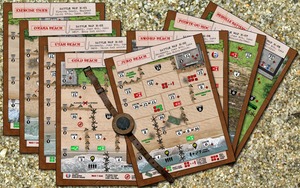 sits at the top of the map, On the way, with the help of your dice, you will find soldiers to join your unit, stars to recruit specialists and items that were dropped by dead soldiers. And you need courage to be able to advance toward the bunker.
sits at the top of the map, On the way, with the help of your dice, you will find soldiers to join your unit, stars to recruit specialists and items that were dropped by dead soldiers. And you need courage to be able to advance toward the bunker.
Gameplay is simultaneous, so no downtime, and cooperative: the players win together or lose together. So they need to trade and share stuff if they want to have a chance. And since it's the Normandy landings, the maps are brutal: you lose soldiers every turn, depending on the "defensive value" of your sector.
The "unique" mechanic of the game is the RWB system: when you roll your dice, you try to obtain a triple result on a red, white and blue die. If you do so, you gain a bonus called an RWB. These bonuses are the key to winning.
So even though you roll dice, the game is not really luck-based. It's more about adjusting your strategy depending on your rolls, managing your resources and moving tactically on the battle map. In a nutshell, there are no bad rolls in D-Day Dice, just bad decisions.
Nerdbloggers:
That sounds like a lot of fun, with some unique mechanics. What was the inspiration for the game, and did you have any design goals when you set out to create it?
Emmanuel Aquin:
I was mostly inspired by 2 things: I played "Roll Through the Ages" and thought is was very bland (although I loved the mechanics), and I discovered a nice print-and-play solo dice game called "The d6 Shooters", by Eric Herman, which was quite entertaining. I'd say these are the main inspirations for D-Day Dice.
And my goal, when designing DDD was simply to create a game that worked. This was my first original design ever. I wanted it to be full of tension, and thematic.
Nerdbloggers:
What was your design process like?
Emmanuel Aquin:
Trial and error, mostly. I had the basic idea of "roll dice to stay alive", then I grabbed a handful of dice. My first prototype was boring as hell, but I had some red, white and blue dice. I was desperate to make it interesting, so I decided to improvise a rule about rolling a triple result on 3 different colors. Once I had that idea, the rest developed itself in a fairly painless manner.
Nerdbloggers:
It's my understanding that D-Day Dice started out as a Print and Play game. Do you think D-Day Dice benefited from it's genesis as a print and play game?
Emmanuel Aquin:
Absolutely. Remember, this was my first design, so I had no idea what I was doing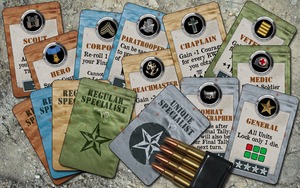 . I thought it was cool, my girlfriend did too, but I couldn't tell if other people -- the ones that weren't sleeping with me -- would enjoy it. Making the game available as a PnP not only gave me access to great feedback from the gaming community, it also gave me the confidence to enter my game in designing contests.
. I thought it was cool, my girlfriend did too, but I couldn't tell if other people -- the ones that weren't sleeping with me -- would enjoy it. Making the game available as a PnP not only gave me access to great feedback from the gaming community, it also gave me the confidence to enter my game in designing contests.
Nerdbloggers:
Will there be differences between the print and play version and the published version?
Emmanuel Aquin:
Changes are big, actually. In the PnP version, when you roll a straight, you win the "Medal of Honor". In the commercial release, there is a slew of "Awards" you can win with a straight (and with select items). Also, instead of a dozen specialists and about 15 items in the PnP, you have 24 specialists, 28 items and 6 vehicles in the Valley Games version. There is more of everything, and with all these new additions come new rules, new twists and more depth.
Nerdbloggers:
As for components, how will the dice look? Has a choice been made between printed or engraved dice?
Emmanuel Aquin:
All the dice will be engraved, including the 4 "unit marker" dice, which serve as both player tokens and turn counters. Since you roll those dice all the time, they need to be durable.
Nerdbloggers:
Kickstarter has become very popular for introducing games lately. What benefits do you feel that Kickstarter gives to a game like D-Day Dice.
Emmanuel Aquin:
Exposure is one of them. Then there is the community aspect of having a group of players join in the fun before the game even reaches the stores. Of course, the money raised ain't nothing to sneeze at, either: it will allow us to print the first expansions at the same time as the base game, which saves money in the long run. On top of all that, it's a great testing ground for the reception your game might have, although, we'll have to wait to verify that statement :-)
Nerdbloggers:
For those reading this after the Kickstarter campaign: Will D-Day Dice be sold through retailers after the Kickstarter has completed? On the other hand, what are the benefits for those who choose to become early adopters and help kickstart the game?
Emmanuel Aquin:
If you join the Kickstarter campaign, you will receive some bonus exclusive cards that are not essential, but fun. In addition, you'll receive a mini-expansion, some cool swag (like "D-Day Dice" pouches and army patches), and a good deal on the game.
If you prefer to wait, the game should reach the stores around April 2012, less the exclusive cards and dice pouches.
Nerdbloggers:
Last question. This one isn't related to board games. November is NaNoWriMo (National Novel Writing Month); aside from your own, what are your favorite novels?
Emmanuel Aquin:
Many are French, as one would expect:
- Mémoires d'un tricheur, by Sacha Guitry (was made into a film by Guitry in 1936)
- L'étranger, by Albert Camus (The Stranger or the Outsider, in English)
- Dieu et nous seuls pouvons, by Michel Folco (about an executioner dynasty in France)
- The Egyptian, by Mika Waltari (adapted into a movie that I never saw)
- The Illustrated Man, by Ray Bradbury
A novel I enjoyed recently was World War Z, by Max Brooks. That one took me by surprise.
I also enjoy good short stories, like the ones from Guy de Maupassant, Richard Matheson, Ray Bradbury, Isaac Asimov and Roald Dahl.
I have to admit, though, that I much prefer non-fiction. I read mostly historical books, biographies and essays. Go figure.
I'd like to extend my thanks to Emmanuel Aquin for taking the time to talk to us about his game, D-Day Dice, and I strongly urge everyone to check out the Kickstarter project!
 Monday, January 16, 2012 at 05:14PM
Monday, January 16, 2012 at 05:14PM 
 Board Game,
Board Game,  RpgFan,
RpgFan,  Super Dungeon Explore,
Super Dungeon Explore,  review in
review in  Board Games
Board Games 



